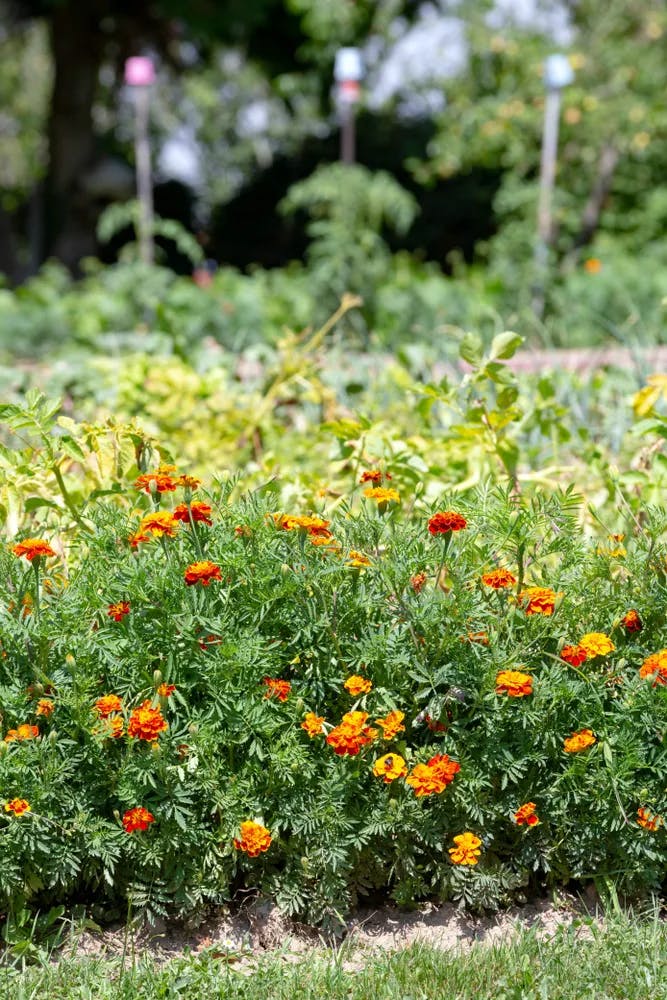GROWING MARIGOLDS IN THE VEGETABLE GARDEN

15 Reasons To Grow Marigolds In The Vegetable Garden
French Marigolds (Tagetes patula) are an excellent plant to grow.
They look lovely in planters, hanging baskets or ornamental beds or borders, but they can also be an excellent addition to your vegetable garden. In fact, they are ranked number one in our list of the best flowers to plant in the vegetable garden.
French marigolds should not be confused with another useful plant –Calendula
Nor should they be confused with African marigold
While both of these other plants can also be great additions to your garden, in this article we are taking about French Marigolds.
Many gardeners do not think to plant flowers in their vegetable garden. But creating polycultures of fruits, vegetables, flowers and herbs can help you to garden organically.
Placing flowers in your vegetable garden will help increase the diversity of plants and wildlife, increase resilience, protect the soil and keep your garden growing strong.
But why choose to grow French marigolds in particular? Why exactly are French marigolds such a great flower to choose? (Their prettiness doesn’t even come into it!)
Here are 15 other reasons to grow these marigolds in your vegetable garden:
1. Marigolds Are Easy To Grow
The first reason that marigolds are such a popular choice is that they are so easy to grow.
Marigolds will grow in a wide range of soil types and conditions. All they really demand is plenty of sunlight. As long as you plant them in areas of full sun, they should be particularly trouble-free plants.
Marigolds can be started from seed around 4-6 weeks before the last frost date in your area and will usually germinate within 1-2 weeks.
You can also consider picking up inexpensive bedding plants from a local garden centre or plant nursery.
Once you have bought marigolds once, you can let some of your plants go to seed, and they should readily self-seed throughout your vegetable garden and pop up the following year as sort of ‘wanted weeds’.
If this more natural and wilder approach does not suit your style, you can also easily collect your own seeds. You can then sow them and plant them where you want to next year.
2. Marigolds Are Edible Plants
You might not realise this, but marigolds are also one of plenty of edible flowers that you could grow amongst your fruits and vegetables. Marigolds are not just a good companion plant – they are an edible crop in their own right.
Egg and Tomato Salad With Marigold and Chive Flowers
The petals of French marigolds can also be added as decoration to cupcakes or other baked goods, and used decoratively in a whole host of other ways in your kitchen.
3. They Produce Chemicals Effective Against Harmful Nematodes
Marigolds are famously excellent as a companion plant. One way in which marigolds are said help their neighbors is by killing nematodes that can cause problems for crops.
What Are Nematodes?
Nematodes are tiny organisms, roundworms, which constitute the phylum Nematoda. The word nematode comes from the Modern Latin ‘nemat’ (thread) (from Greek ‘nema’) and ‘odes’ (like, of the nature of). There are a huge number of different species of these small, thread-like creatures.
Some nematodes cause problems for plants and people. But others are beneficial – involved in some important jobs in the soil and around your garden.
Can Planting Marigolds Really Help With Nematode Problems?
There is a lot of confusion surrounding this issue. The subject is not as clear cut as some gardeners believe. Marigolds do produce compounds in their roots that are nematicides.
But it is important to understand that there are a huge range of different nematodes that can become a problem, and home gardeners will usually be unable to determine which ones they have in their soil.
When certain French marigolds are infested with certain nematodes, they kill them off in that particular spot and reduce their numbers. This can bring harmful nematode populations down.
Marigolds may also excrete a chemical which can repel nematodes in the surrounding area.
Planting marigolds in a given, exact location in your vegetable beds before the vegetables can, however, definitely reduce certain nematodes there and make it less likely that crops immediately following them will be struck.
Growing marigolds can help control a nematode population, such as root rot nematodes.
4. Marigolds Attract Bees & Other Pollinators
Marigolds can bloom over quite a long period of time. Their blooms are therefore an excellent resource for bees and pollinators throughout the growing season.
Some marigolds are better than others for certain pollinating insect species – but many can help to draw them into your garden.
For a number of pollinators, single flower types are better than doubles, as it will be easier for them to reach the heart of the flowers. But always try to choose as many different flowers for your garden as possible, to encourage all the different pollinators that live in your area.
They don’t just draw in those pollinators, they also draw in insects to help you in organic pest control.
Marigolds can help to bring in ladybugs, lacewings, hoverflies, parasitic mini-wasps and other predatory insects that will eat aphids and other pests which can damage your crops.
Attracting such beneficial insect species to your garden will help to keep the ecosystem in balance and should make it less likely that any pest problems will get out of control.
6. Marigolds May Be an Effective Trap Crop
Marigolds may also be somewhat effective as a trap crop for certain pest species. A trap crop is a crop that lures pests to them, to keep them away from other, more valuable crops.
For example, slugs love marigolds, so planting a ring of ‘sacrificial’ marigolds around the edges of a bed might help to protect your crops. The slugs will be drawn to the marigolds. And while you will likely lose some plants, you can spot them on the marigolds and collect them up before they become a big problem for other plants in your garden.
7. They May Repel Certain Pests
There are all sorts of claims out there for the pests that marigolds repel when planted in your vegetable garden.
Claims that marigolds can repel deer or rabbits are, unfortunately, completely unfounded. These flowers will not keep either of these animals out of your vegetable garden.
There is, however, some evidence to suggest that marigolds may be at least partially successful in repelling certain pests – such as cabbage moths and Mexican bean beetles. And scientists have determined that marigolds secretion of limonene can help (at least a little) in repelling whiteflies.
8. They Attract Butterflies To Your Garden
Marigolds can also be a great plant choice for attracting butterflies to your garden. Tagetes patula can be particularly successful in drawing in these beautiful creatures.
Note, single flower varieties will be more beneficial for butterflies, as they will be more easily able to access their nectar.
9. Marigolds Can Be Used To Make Natural Yellow Food Colouring
Marigold petals are often used to bulk out saffron, or as a ‘poor mans’ saffron alternative. They can impart a natural yellow colouring to food.
They can be used in soups, stews etc., or to make a natural colored icing for cakes or confectionary.
The petals are sometimes also fed to chickens, to impart a natural rich golden tone to egg yolks.
10. You Can Use Them To Make a Natural Fabric Dye
The intense pigment in the petals can also be used to make a natural dye for fabrics.
Marigolds are wonderful for dyeing natural fabrics like silk, cotton, hemp, wool etc.. They will not stick as successfully to synthetic fabrics.
The vibrant yellow tones that can be derived from marigolds are particularly prized in natural dyeing, because they are easy to extract and do not necessarily require the use of a mordant, like alum, for the color to stick.
11. They Can Yield an Essential Oil, Used in Perfumery
Scented French marigolds are also useful because they can provide a yield of essential oil. The whole plant is used in distillation.
This essential oil is used in a range of ways, including in perfumery. Marigold essential oil is blended with sandalwood oil to produce ‘attar genda’ perfume.
12. Marigolds Can Be Cut For Floral Displays
Marigolds will, of course, add a beautiful pop of colour in your garden. But you can also cut them for floral displays inside your home. See some beautiful examples in the link below:
You can also string marigolds to make beautiful garlands for your home or garden, or for a special event. Such garlands are popular for weddings and other special occasions in India, and are also popular for the Mexican Day of the Dead.
13. They Can Also Be Dried To Create Longer Lasting Arrangements
Marigolds are also a flower that is suitable for drying.
To dry your marigolds, you can use a number of different methods.
The easiest method is simply to hang bunches of the flowers to dry in a warm and low humidity area. The area should have good air circulation and be out of direct sunlight. Then simply leave your marigolds to dry there, undisturbed, for 2-4 weeks.
You can use dried marigolds in a range of decorative ways around your home.
You can also dry and store the petals for making marigold tea. A tea made from marigolds has a mild, rather bland flavour but gives good colour. Marigold petals are therefore often mixed with other botanicals, like mint, for example.
14. Marigolds Are Useful For Soap Making (And Other Cleanin
Marigolds can also be a useful plant when it comes to soap making, and the making of other cleaning and beauty products.
15. You Can Chop and Drop Marigolds You Don’t Harvest To Feed the Soil
Finally, you can also chop and drop your marigolds at the end of the growing season to add organic matter to the growing areas.
There is some evidence to suggest that this may help to reduce nematode issues. It may not kill the nematodes themselves after the living plants are felled. But it is believed that the increase in organic matter will promote populations of beneficial soil life that will help to keep negative nematode numbers down.
How To Incorporate Marigolds in Your Vegetable Garden
As you can see, there are plenty of reasons to grow marigolds in the vegetable garden. But how and where exactly should you incorporate them?
There are several different ways to include marigolds in your planting schemes. Which one you opt for will largely depend on your main motivations for growing them.
You can incorporate marigolds:
- As single companion plants, dotted naturalistically throughout your vegetable beds.
- In wild profusion in between other plants in polyculture planting schemes.
- As neater intercropping, between rows of vegetables or fruits.
- To form borders around the edges of your growing areas.
As a cover crop.
ENJOY PLANNING YOUR SPRING PLANTING 2022











